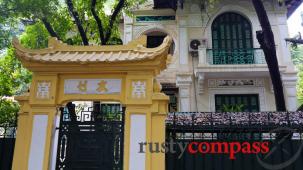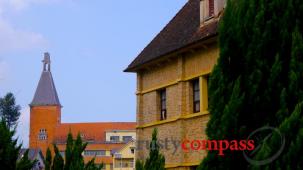A classic old quarter street corner. Hanoi
Cars, motorbikes, cyclos, bicycles and that lowest form in the Vietnamese street pecking order, the pedestrian, all vie for space in the Old Quarter's narrow streets.
Look above the shopfronts for a view of the original buildings
The old quarter once had a thriving Chinese community. Many left when relations between the two countries soured in 1979. Many buildings still display fading Chinese characters.
This house at 87 Ma May St is a great place to get a view of what the Old Quarter houses used to look like. It has been renovated with UNESCO assistance to its original condition and is now open for travellers. It features some beautiful timber carving and the classic use of courtyard space and ventilation to ensure such long narrow buildings enjoyed plenty of air flow and natural light. The awkward narrow frontages of the houses of the Old Quarter followed a French edict that based taxation on the dimensions of the shopfront.
This man frequently works at 87 Ma May St practicing the dying art of Vietnamese calligraphy - known as Chu Nom. Chu Nom was a Vietnamese adaptation of the Chinese script that was used by the royal court, mandarins and poets for centuries. By the turn of the twentieth century, French authorities vigourously discouraged its use consigning it to the corridors of academe. The near destruction of the art of Chu Nom must rank as one of the great cultural crimes of the French colonial era.
Some of the oldest buildings of the Old Quarter are temples and pagodas. This is Ba Da Pagoda on the fringes of the Old Quarter.
A ninety year old man at Ba Da Pagoda. The visibility and vigour of Hanoi's elderly is one of the great attractions of the city.
Mother and daughter at the old fan shop - with its sticky rice stall out the front.
The old fan shop - Old Quarter Hanoi.
Peering beyond the shopfronts is one of the most interesting things about a walk in the Old Quarter.
Churning out flags and other nationalist paraphernalia. Marx and Lenin still get a good run alongside Uncle Ho. Hard to know how any of them would feel about how things have turned out.
Jon Stewart may not be aware that he has a gig promoting a tailor in Hanoi's Old Quarter. A man of many talents.
Hanoi's Old Quarter.
The house in which Ho Chi Minh penned his country's declaration of independence in 1945. The declaration drew heavily on the United States' version. Having worked closely with US intelligence in defeating the Japanese, Ho did not yet realise that the country that inspired core elements of his declaration would become a bitter enemy in the following decades.
One of the last remnants of Hanoi's city walls in the Old Quarter
Some of Hanoi's best streets food and more upscale dining is to be found in the Old Quarter. Bun cha is a Hanoi specialty that shouldn't be missed.
Bun cha stall in Hang Manh St.
Classic bun cha - a simple dish of noodles (bun), grilled pork, essential Vietnamese greenery and fish sauce. Spectacular!
This thriving bun nem stall on Dao Duy Tu St is a great local lunchstop. Bun nem consists of noodles, Hanoi spring rolls, more greenery and fish sauce. Also delicious!
Bun Nem - another dish not to be missed.
Another Hanoi Old Quarter speciality not to be missed is cha ca. Cha ca is fairly oily but very tasty nooodle and fish dish that gets its unique flavours from an assortment of peanuts, greens, turmeric and dill. The real falvour hit however comes from a fermented add as a result very pungent shrimp sauce called mam tom. The smell of mam tom will definitely confront but if you can get past that, this sauce will be the highlight of your cha ca experience.
And some more upscale dining in a lovely setting - Green Tangerine Restaurant in Hang Be St
Legends' Beer in Hanoi is a great place to finish the day with views across the chaos at the opening of the Old Quarter and the calm of Hoan Kiem Lake.





































